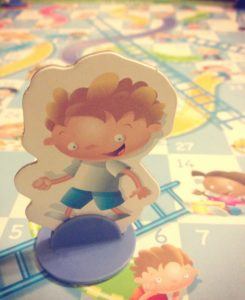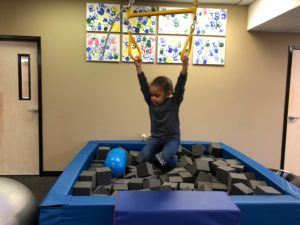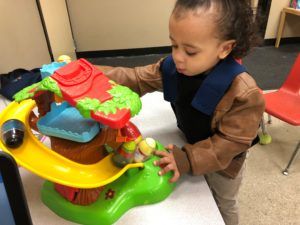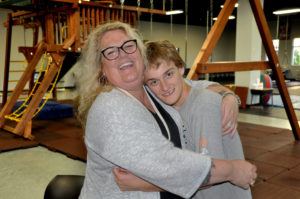Month: December 2018
- Speech Sound Grab Bag: Fill a medium sized gift bag or tote bag with small objects/pictures that begin (or end) with the targeted sound. Have your child take out each object and practice saying that word and talk about what he/she found. Your child will love digging into the bag and feeling the objects inside to see what is hidden inside!
For example: /k/ sound objects could include keys, (pretend) cookie, cup, kit-kat bar, rubber duck (quack-quack AND final /k/ in duck), book, ketchup packet, small stuffed animal cat, cork, can of soda or coke, small cake candle, pretend slice of cake, napkin, plastic/toy fork, packet of hot cocoa)
- Flashlight Game: Get out a flashlight and place pictures or objects that target the speech sound and place them inside child’s bedroom or other room, turn off the lights and have the child shine the light around the room to “find” the objects. Your child will love playing with the flashlight and searching for the cards or objects.

- Memory match up: Make small cards (with photos or clipart) with targeted speech sound so that you and your child
 can play the memory matching game. Place all cards face down and have your child see if they can remember where the cards are and whoever has the most matches wins the game.
can play the memory matching game. Place all cards face down and have your child see if they can remember where the cards are and whoever has the most matches wins the game. - Book Reading: Choose a book from your local library that targets the speech sound, read with your child (or maybe they can read to you!)
- Board Games: Incorporate your child’s favorite board game and upon taking a turn, have your child say a word 2-3 times targeting that speech sound (see if your child’s speech pathologist can give you a practice word list or photocopied pics). Game suggestions: Candyland, Chutes and Ladders, UNO, Guess Who?)

- Sound guessing game: Practice “sound discrimination” at
- home by hiding your mouth with a piece of construction paper. Say a word that begins with the targeted sound (i.e. “seat”) and ask the child, “Did I say the /s/ or the /sh/ sound?” Choose words that rhyme but begin with the targeted speech sounds. (i.e. cake/take)
- Build a “road” for cars: line picture cards for targeted speech sound face down, have your child help you build a “road” and turn over the cards as the car “drives’ along the road, saying the sound as the cards are turned over.
- B-I-N-G-O: Use a bingo board and markers/chips that contain pictures of the targeted speech sound. This is a great way to include multiple family members!
- Coloring: Use coloring sheets that include popular cartoon characters or scenes with targeted speech sounds. Sit with your child and have the child say one of the targeted words before receiving a crayon or marker to color a certain part of the coloring sheet. This way they are coloring as they are practicing the sounds.
- Baking or Crafting: Have your child bake or put together a craft and target that sound during the activity. Examples of targeted words: cookies, cake, rolling pin, pat-pat-pat, push, cookie cutters, shapes, cook, bake, hot, mix, stir, egg, break, roll, pull, glue, stick/sticky, cut, in, out.
By the time a toddler has a vocabulary of at least 30-40 words, they begin to put words together into 2-word phrases (the child must be USING the 30-40 words in spontaneous speech to comment/request/label, not just imitating). The general “rule of thumb” is that at age one, children use only ONE word to communicate, then at age two, they use TWO words, by age three, they are using THREE or more words in sentences (requesting/commenting/asking & answering questions). I find myself using the following strategies right now with my 24-month-old and thought I’d share some ways to help increase the 2-word phrases in your toddler’s vocabulary.
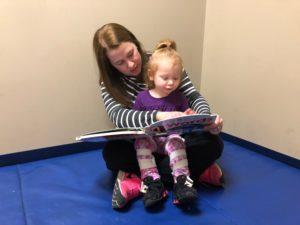
- One simple way is to build phrases using words your child already has in their vocab.: Does your child have some functional words associated with mealtime, bedtime, playtime etc.??? Try adding MORE and PLEASE to those words. For example, “more juice”, “help please”, “out please”. “more crackers”, “up please”.
- Incorporate greetings to build phrases: “Hi daddy”. “bye-bye nana”

- Model phrases throughout your daily routines, commenting on what is happening or what your child is doing, “night-night baby”, “go out”, “want up?”, “purple ball”, the more these phrases are modeled, the greater the chance your child will begin to imitate!
- Incorporate “automatic” phrases as well: For example, “I did it”, “this one”, “that one”, “my turn”, “let’s go”, “no mine”
- If you notice that your child isn’t quite catching on to 2-word phrase imitation, begin by repeating single words in a string, for example, “go-go-go!”, “up-up-up”, “night-night” to see how they respond.
If you have concerns about your child’s development, visit our webpage at https://www.abcpediatrictherapy.com for more information.
Written by: Christina Sanford, MA, CCC-SLP
Read More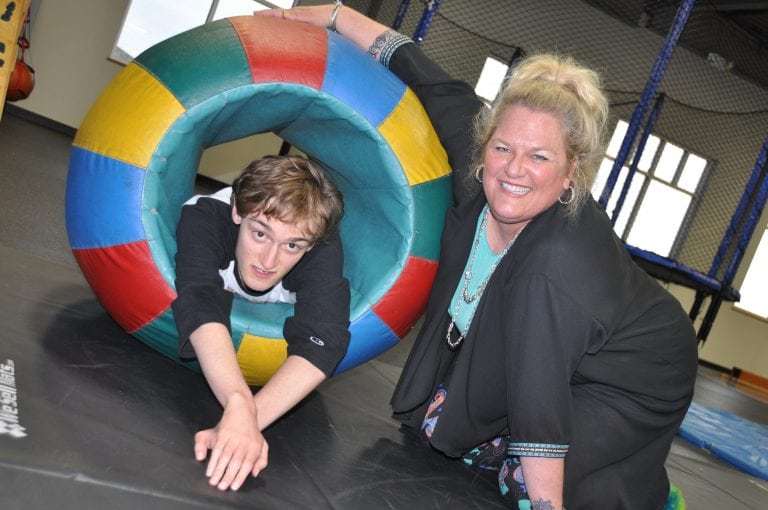 When Jakob was little, he seemed so disconnected. I never knew if he was listening to anything I was saying. I didn’t know if he even knew his own name. He rarely showed any interest in anything I was doing or wanted to do with him. I tried reading books, building blocks, singing the ABC’s. His only interests were jumping on his trampoline, watching his favorite DVD’s (Baby Einstein, Sesame Street and Signing Time,) and playing with all his battery operated toys. He could go hours without even acknowledging I was in the room. I wasn’t sure if he had any interest in a relationship with me that involved interaction, affection, and communication or if he just didn’t know how to connect.
When Jakob was little, he seemed so disconnected. I never knew if he was listening to anything I was saying. I didn’t know if he even knew his own name. He rarely showed any interest in anything I was doing or wanted to do with him. I tried reading books, building blocks, singing the ABC’s. His only interests were jumping on his trampoline, watching his favorite DVD’s (Baby Einstein, Sesame Street and Signing Time,) and playing with all his battery operated toys. He could go hours without even acknowledging I was in the room. I wasn’t sure if he had any interest in a relationship with me that involved interaction, affection, and communication or if he just didn’t know how to connect.
The only thing that was apparent was he had quite the wonderful relationship with electronics. They entertained him and made him smile. I would find myself a little jealous of Elmo and Big Bird. I wanted my son to look at me with that same gleam in his eye and to laugh at the things I was doing and saying. I had to remind myself to be glad that he was having fun but I was so very sad that it wasn’t with me.
I spent years thinking that I was destined to forever have a kid who wanted nothing to do with me. He would come to me to be fed but that was it. Then one day while I was watching him giggle hysterically at something Cookie Monster said, I had a realization. I could never compete with all that. The toys and videos had mesmerizing sights and sounds and sound effects and characters. They were irresistible. They were far more interesting than anything I could do. As long as they remained in his world as options, I would always lose. So one day when he was out of the house, I gave it all away.
It was a tough decision. I was taking away all the things he loved most. The things that made him the happiest. The only things in his life that made him laugh. But I knew that if I was going to reach him and inspire him to want to be, really be, with people, it all had to go. And I also knew that I would have to sit with the confused and sad tears while he mourned the loss. While I comforted, I knew I had to reassure him in a positive and enthusiastic way that we were going to have so much fun together. And I immediately sprung into action showing him exactly how we were going to do just that.
I took some of his favorite things from the videos and games and turned myself into them. I was a sound effect machine that would make different noises when he poked me in the arm or touched my nose. I was Super Grover stumbling awkwardly all over the place. (He loved slapstick humor so I fell down a lot.) I had puppets and stuffed animals of some of his favorite characters and they did all sorts of silly things. At first he couldn’t quite figure out what I was doing but he eventually caught on. And when he did, he thought it was a hoot. There was endless material for me to have fun with and it didn’t take long before my wish came true. My Jakob was looking at me with that Sesame Street gleam in his eye and he was laughing right along with me. It was a beautiful thing.
After a few years, Jakob got an iPad and he found a couple games he liked. He would play a little bit here and there but would always put it down when he wanted to play with me. There was never a fight about it. Time passed and he played with it less and less. He eventually decided he was done and he deleted all his games and put his iPad away. He has an iPod now that he uses to send text messages and emails on occasion. But it’s used mostly to check out traffic issues, route our trips and figure out detours when roadwork is necessary.
I’m so glad I made that tough decision when I did. I think it saved us both from an addiction that would have done us harm. And it undeniably helped create a bond that no muppet or screen can ever break.
Read More Skip to content
Skip to content
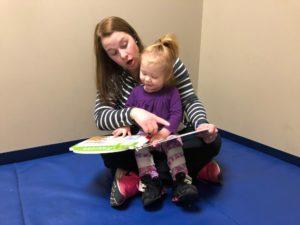

 can play the memory matching game. Place all cards face down and have your child see if they can remember where the cards are and whoever has the most matches wins the game.
can play the memory matching game. Place all cards face down and have your child see if they can remember where the cards are and whoever has the most matches wins the game.